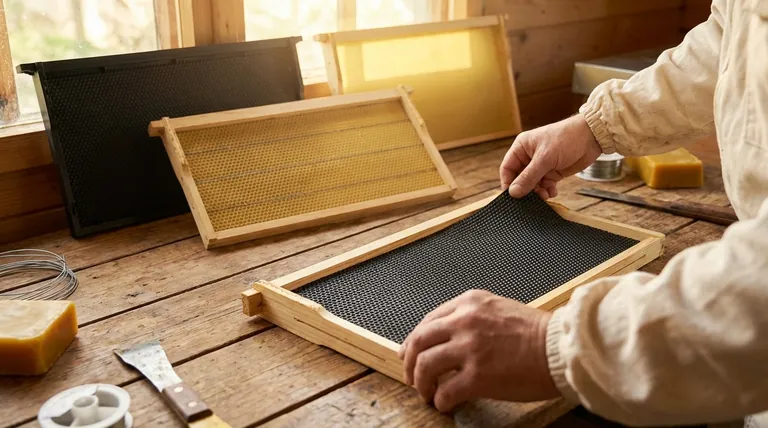The primary methods for installing foundation involve either sliding a sheet of plastic foundation into grooves in the frame or embedding a more delicate sheet of beeswax, which often requires wire reinforcement. The simplest options bypass manual installation altogether, utilizing all-in-one plastic frames or pre-assembled units where the foundation is already mounted for you.
Your choice of foundation and installation method is a fundamental decision that balances convenience against control. Easy-to-install plastic offers speed and durability, while traditional beeswax and foundationless methods provide a more natural environment at the cost of more labor.

The Easiest Path: Ready-to-Use Solutions
For beekeepers prioritizing speed and simplicity, the best options require no installation work at all. These are designed to go from the box directly into the hive.
All-in-One Plastic Frames
These units combine the frame and foundation into a single, durable piece of plastic. There is nothing to assemble or install.
They are incredibly robust and stand up well to the forces of honey extraction. Their primary requirement is a solid coating of beeswax to encourage the bees to build comb on them.
Pre-Assembled Wood Frames
This option consists of a standard wooden frame with the foundation—either wax or plastic—already installed by the manufacturer.
This saves significant time and removes the learning curve of wiring or embedding foundation, making it a popular choice for new beekeepers.
The Hands-On Approach: Manual Installation
If you prefer to buy frames and foundation separately, you will need to install the foundation yourself. The method depends entirely on the material you choose.
Installing Plastic Foundation
Plastic foundation sheets are rigid and designed for easy installation. Most modern wooden or plastic frames feature a groove or slit in the top and bottom bars.
You simply flex the foundation sheet and slide it into these grooves. The most critical step is ensuring the foundation is heavily coated in beeswax, whether you buy it pre-waxed or apply a thin layer of melted wax yourself. Without a good wax coating, bees may be reluctant to draw comb on the plastic.
Installing Beeswax Foundation
Pure beeswax foundation is the most traditional option but is also the most fragile. It must be reinforced to prevent it from sagging in the heat or blowing out during honey extraction.
The most common method is using crimped wire embedded horizontally within the wax sheet. Many beekeepers also thread vertical wires through the frame itself, using a special tool called an embedder to heat the wires and melt them gently into the foundation, securing it firmly in place.
Alternative Methods for Natural Beekeeping
Some beekeepers prefer to give the bees more control over comb construction. These foundationless methods are popular in natural or treatment-free beekeeping.
Using Starter Strips
Instead of a full sheet of foundation, you can provide the bees with a simple guide. This is often a 1-2 inch strip of beeswax foundation inserted into the top bar's groove.
Alternatively, a simple wooden guide, like a popsicle stick or a beveled top bar, can serve the same purpose. The bees will use this guide to start building their own comb downwards, determining cell size themselves.
Understanding the Trade-offs
Each approach has clear benefits and drawbacks. Understanding them is key to aligning your equipment with your beekeeping goals.
Durability for Honey Extraction
This is where foundation choice matters most. Plastic foundation and wired beeswax foundation provide the rigidity needed to withstand the centrifugal force of a honey extractor.
Foundationless comb is extremely fragile and will almost certainly break apart during extraction. It is best suited for beekeepers who plan to harvest honey by crushing the comb.
Ease of Use vs. Bee Acceptance
All-in-one plastic frames are undeniably the fastest and easiest option. However, bees will always accept and build on pure beeswax more readily than on plastic.
A heavy wax coating on plastic foundation is not optional; it is essential to bridge this acceptance gap and ensure the bees don't ignore the frames.
Control Over Cell Size
Using full sheets of foundation, whether wax or plastic, means you are dictating the cell size to the bees. The pre-embossed hexagonal pattern is sized for worker bees.
A foundationless approach allows the colony to build comb to its own specifications, including larger drone cells, which is a key goal for some natural beekeeping philosophies.
Making the Right Choice for Your Goal
Your decision should be guided by your primary objective as a beekeeper.
- If your primary focus is speed and simplicity: Choose all-in-one plastic frames or pre-assembled wooden frames with foundation already installed.
- If your primary focus is efficient honey extraction: Use durable plastic foundation or beeswax foundation that has been properly reinforced with wire.
- If your primary focus is natural comb building: Use foundationless frames with a small starter strip to give the bees maximum control.
Ultimately, selecting the right foundation strategy is about aligning your equipment with the needs of your bees and your personal beekeeping philosophy.
Summary Table:
| Method | Best For | Key Feature |
|---|---|---|
| All-in-One Plastic Frames | Speed & Simplicity | No assembly; durable for extraction |
| Pre-Assembled Wood Frames | New Beekeepers | Foundation pre-installed |
| Manual Plastic Foundation | Efficient Honey Production | Slides into grooves; requires wax coating |
| Manual Beeswax Foundation | Traditional Beekeeping | Requires wire reinforcement; natural material |
| Foundationless/Starter Strips | Natural Beekeeping | Bees build comb naturally; fragile for extraction |
Ready to streamline your beekeeping operation?
As a commercial beekeeper or equipment distributor, the right foundation strategy is critical for efficiency and honey production. HONESTBEE supplies durable, wholesale-priced foundation and frames—from robust all-in-one plastic units for high-volume extraction to traditional beeswax sheets for natural operations.
Let our experts help you select the perfect equipment to meet your apiary's specific goals. Contact HONESTBEE today for wholesale pricing and expert advice.
Visual Guide

Related Products
- Plastic Bee Frame Beekeeping Hive Frames for Wholesale
- HONESTBEE Wired and Assembled Wooden Bee Frames Foundation for a Thriving Hive
- Beeswax Foundation Sheets Beehive Foundation for Wholesale
- Food Grade Plastic bee Foundation for Bee Frames
- Durable Rubberized Comfort Handle Frame Grip
People Also Ask
- What are the differences between wooden and plastic frames in beehives? Choose the Best for Your Apiary
- What are the advantages of plastic frames for beehives? Boost Apiary Efficiency & Durability
- Are plastic frames good? Boost Apiary Efficiency with Durable, Pest-Resistant Frames
- What is a general rule for beekeepers with many hives regarding frame choice? Maximize Efficiency with Plastic Frames
- Are plastic bee hive frames good? A Guide to Modern Durability vs. Natural Appeal



















